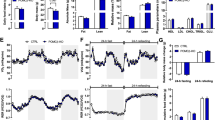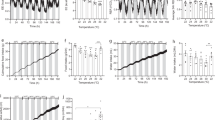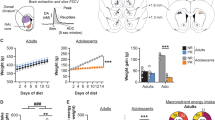Abstract
Pancreatic polypeptide (PP) has been shown to inhibit food intake in both rodents and humans. Acute peripheral administration of PP increases oxygen consumption in obese mice. To further investigate the function of PP in the modulation of energy balance, we examined its effects on spontaneous locomotor activity and food intake in mice by using a 24-chamber Comprehensive Laboratory Animal Monitoring System. Effects of intraperitoneal (i.p.) administration of PP on spontaneous locomotor activity were measured using the optical beam technique. Administration of PP dose dependently inhibited cumulative food intake. The inhibition remained significant for up to 6, 17 and 36 h at doses of 30, 100 and 300 nmol kg−1 PP, respectively. At 10 nmol kg−1, PP increased locomotor activity (cumulative beam breaks) significantly for 4 h following administration without affecting food intake and at 30 nmol kg−1, PP increased locomotor activity by 79% compared with the controls for 5 h post injection. However, at 100 and 300 nmol kg−1, PP had no significant effect on locomotor activity. This study shows for the first time that PP increases spontaneous locomotor activity in mice.
This is a preview of subscription content, access via your institution
Access options
Subscribe to this journal
Receive 12 print issues and online access
$259.00 per year
only $21.58 per issue
Buy this article
- Purchase on Springer Link
- Instant access to full article PDF
Prices may be subject to local taxes which are calculated during checkout


Similar content being viewed by others
References
Tatemoto K, Carlquist M, Mutt V . Neuropeptide Y-a novel brain peptide with structural similarities to peptide YY and pancreatic polypeptide. Nature 1982; 296: 659–660.
Adrian TE, Bloom SR, Bryant MG, Polak JM, Heitz PH, Barnes AJ . Distribution and release of human pancreatic polypeptide. Gut 1976; 17: 940–944.
Zipf WB, O’Dorisio TM, Cataland S, Sotos J . Blunted pancreatic polypeptide responses in children with obesity of Prader-Willi syndrome. J Clin Endocrinol Metab 1981; 52: 1264–1266.
Glaser B, Zoghlin G, Pienta K, Vinik AI . Pancreatic polypeptide response to secretion in obesity: effects of glucose intolerance. Horm Metab Res 1988; 20: 288–292.
Uhe AM, Szmukler GI, Collier GR, Hansky J, O’Dea K, Young GP . Potential regulators of feeding behavior in anorexia nervosa. Am J Clin Nutr 1992; 55: 28–32.
McLaughlin CL, Baile CA . Obese mice and the satiety effects of cholecystokinin, bombesin and pancreatic polypeptide. Physiol Behav 1981; 26: 433–437.
Asakawa A, Inui A, Ueno N, Fujimiya M, Fujino MA, Kasuga M . Mouse pancreatic polypeptide modulates food intake, while not influencing anxiety in mice. Peptides 1999; 20: 1445–1448.
Batterham RL, Le Roux CW, Cohen MA, Park AJ, Ellis SM, Patterson M et al. Pancreatic polypeptide reduces appetite and food intake in humans. J Clin Endocrinol Metab 2003; 88: 3989–3992.
Asakawa A, Inui A, Yuzuriha H, Ueno N, Katsuura G, Fujimiya M et al. Charaterization of the effects of pancreatic polypeptide in the regulation of energy balance. Gastroenterology 2003; 124: 1325–1336.
Castañeda TR, Jürgens H, Wiedmer P, Pfluger P, Diano S, Horvath TL et al. Obesity and the neuroendocrine control of energy homeostatsis: the role of spontaneous locomotor activity. J Nutr 2005; 135: 1314–1319.
Teske JA, Billington CJ, Kotz CM . Neuropeptidergic mediators of spontaneous physical activity and non-exercise activity thermogenesis. Neuroendocrinology 2008; 87: 71–90.
Tang-Christensen M, Vrang N, Ortmann S, Bidlingmaier M, Horvath TL, Tschöp M . Ghrelin increases food intake and decreases spontaneous locomotor activity in rats. Endocrinology 2004; 145: 4645–4652.
Wynne K, Park AJ, Small CJ, Meeran K, Ghatei MA, Frost GS et al. Oxyntomodulin increases energy expenditure in addition to decreasing energy intake in overweight and obese humans: a randomised controlled trial. Int J Obes 2006; 30: 1729–1736.
Levine JA, Eberhardt NL, Jensen MD . Role of nonexercise activity thermogenesis in resistance to fat gain in humans. Science 1999; 283: 212–214.
Tou JC, Wade CE . Determinants affecting physical activity levels in animal models. Exp Biol Med 2002; 227: 587–600.
Bard JA, Walker MW, Branchek TA, Weinshank RL . Cloning and functional expression of human Y4 subtype receptor for pancreatic polypeptide, neuropetide Y, and peptide YY. J Biol Chem 1995; 270: 26762–26765.
Pich EM, Agnati LF, Zini I, Marrama P, Carani C . Neuropeptide Y produces anxiolytic effects in spontaneously hypertensive rats. Peptides 1993; 14: 909–912.
Rodgers RJ, Halford JC, Nunes de Souza RL, Canto de Souza AL, Piper DC, Arch JR et al. Dose-response effects of orexin-A on food intake and the behavioural satiety sequence in rats. Regul Pept 2000; 96: 71–84.
Amant M, Kashtanov SI, Fodor M, de Wied D . Corticotropin-releasing factor induces differential behavioural and cardiovascular effects after intracerebroventricular and lateral hypothalamic/perifornical injections in rats. Neuroendocrinology 1992; 56: 750–760.
De Groote L, Penalva RG, Flachskamm C, Reul JM, Linthorst AG . Differential monoaminergic, neuroendocrine and behavioural responses after central administration of corticotropin-releasing factor receptor type 1 and type 2 agonist. J Neurochem 2005; 94: 45–56.
Acknowledgements
We thank J Eliahoo (Statistical Advisory Service, Imperial College London) for statistical advice. This research was funded in part by programme grants from the MRC (G7811974) and Wellcome Trust (072643/Z/03/Z) and by an EU FP6 Integrated Project Grant LSHM-CT-2003-503041. We are also grateful for support from the NIHR Biomedical Research Centre funding scheme.
Author information
Authors and Affiliations
Corresponding author
Rights and permissions
About this article
Cite this article
Liu, YL., Semjonous, N., Murphy, K. et al. The effects of pancreatic polypeptide on locomotor activity and food intake in mice. Int J Obes 32, 1712–1715 (2008). https://doi.org/10.1038/ijo.2008.160
Received:
Revised:
Accepted:
Published:
Issue Date:
DOI: https://doi.org/10.1038/ijo.2008.160
Keywords
This article is cited by
-
The Implication of Gut Hormones in the Regulation of Energy Homeostasis and Their Role in the Pathophysiology of Obesity
Current Obesity Reports (2020)



